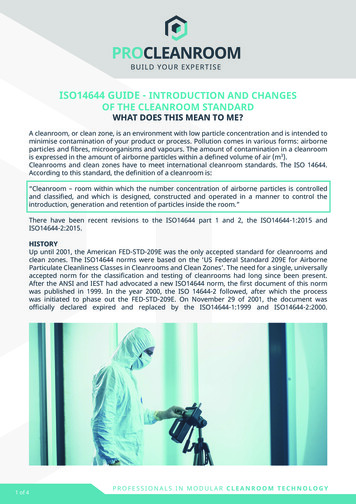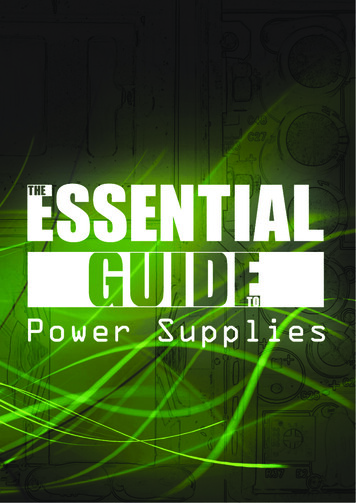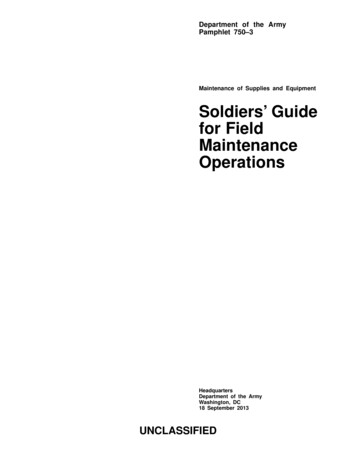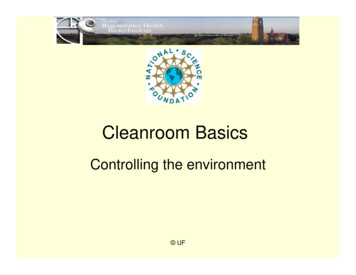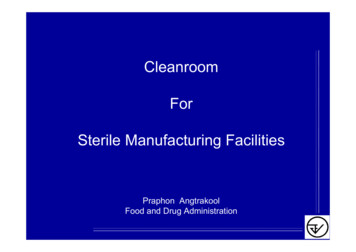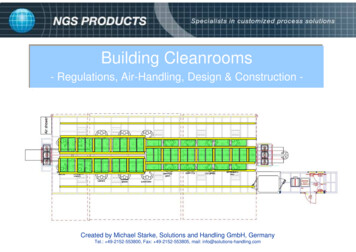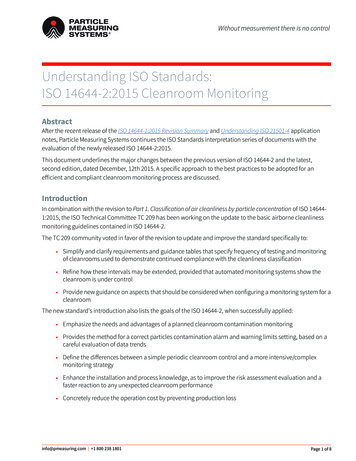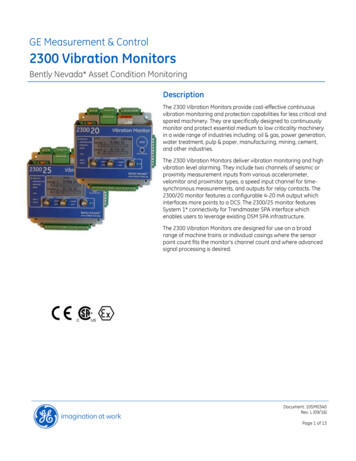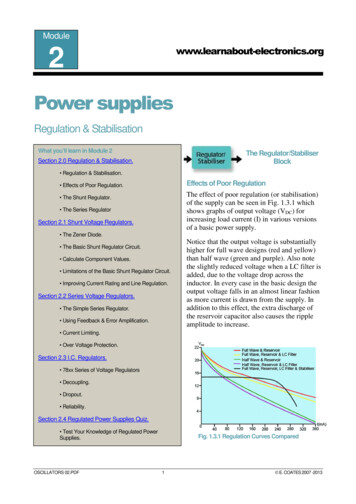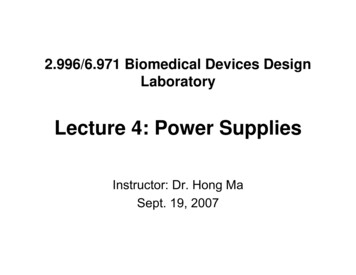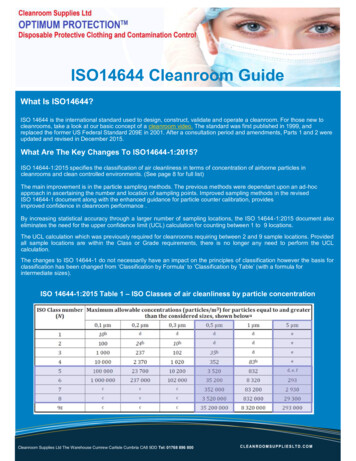
Transcription
ISO14644 Cleanroom GuideWhat Is ISO14644?ISO 14644 is the international standard used to design, construct, validate and operate a cleanroom. For those new tocleanrooms, take a look at our basic concept of a cleanroom video. The standard was first published in 1999, andreplaced the former US Federal Standard 209E in 2001. After a consultation period and amendments, Parts 1 and 2 wereupdated and revised in December 2015.What Are The Key Changes To ISO14644-1:2015?ISO 14644-1:2015 specifies the classification of air cleanliness in terms of concentration of airborne particles incleanrooms and clean controlled environments. (See page 8 for full list)The main improvement is in the particle sampling methods. The previous methods were dependant upon an ad-hocapproach in ascertaining the number and location of sampling points. Improved sampling methods in the revisedISO 14644-1 document along with the enhanced guidance for particle counter calibration, providesimproved confidence in cleanroom performance .By increasing statistical accuracy through a larger number of sampling locations, the ISO 14644-1:2015 document alsoeliminates the need for the upper confidence limit (UCL) calculation for counting between 1 to 9 locations.The UCL calculation which was previously required for cleanrooms requiring between 2 and 9 sample locations. Providedall sample locations are within the Class or Grade requirements, there is no longer any need to perform the UCLcalculation.The changes to ISO 14644-1 do not necessarily have an impact on the principles of classification however the basis forclassification has been changed from ‘Classification by Formula’ to ‘Classification by Table’ (with a formula forintermediate sizes).ISO 14644-1:2015 Table 1 – ISO Classes of air cleanliness by particle concentrationCleanroom Supplies Ltd The Warehouse Cumrew Carlisle Cumbria CA8 9DD Tel: 01768 896 800
What Are The Implications For EU GMP Cleanroom Operators?This guide aims to provide a brief overview of the changes, but more importantly, how the changes affect thecurrent Guide to GMP for Medicinal Products – Annex 1 Manufacture of sterile medicinal products and the average pharmaceutical cleanroom. The application and uncertainty of 5.0µm particles in Grade A and GradeB environments for classification and monitoring to ISO 5It will impact on every GMP Pharmaceuticals cleanroom user.The fundamental changes in the ISO 14644-1:2015 document impacting on the GMP community are: Change to the method for calculating number of sample locations for classification or re-qualification Elimination of the 95% Upper Confidence Limit (UCL) calculation Reference to ISO 21501-4 in the normative* Annex A where the requirements for air particle counters aredefined (*normative must comply with this section) Removal of the maximum allowable concentration of airborne particles/m³ 5 microns for ISO Class 5from the Cleanliness Classes table (ISO Class 5 at 5microns is equivalent to GMP Grade B at rest)All GMP cleanroom users will have to make changes to their cleanroom classification or re-qualification SOPsto incorporate the larger number of sampling points required in the new version of the ISO standard. In somecases a risk assessment may be required to retrospectively investigate the potential impact on product qualityif the new classification/re-qualification changes the cleanroom Class or Grade. In some cases where this isthe case, the cleanroom owner may have to consider making changes to their cleanroom and air handlingsystems to bring the cleanroom back into the required Class or Grade.All GMP cleanroom users will have to ensure that the particle counters used to classify and monitor theircleanrooms are compliant with the requirements of ISO 21501-4, including those counters forming a part of acontinuous monitoring system.All SOPs and qualification protocols in pharmaceutical manufacturing related to the HVAC system and cleanroom operation should be changed accordingly.Although EU GMP and USA cGMP both define the airborne particle counts/m³ for each cleanliness class orgrade, they do not contain guidance on the cleanroom classification procedure. Instead they point the readerto ISO 14644-1 for the cleanroom classification methodology. As part of the routine periodic review process,the ISO committee responsible for ISO 14644-1 decided that areas of the classification process required revision to improve statistical accuracy.Cleanroom Supplies Ltd The Warehouse Cumrew Carlisle Cumbria CA8 9DD Tel: 01768 896 800
In ISO 1,2,3 and ISO 5 classes, the particle diameter that could be taken as a reference has been changed.The most significant reflection of it to the industry is that the limit which was 29 particles for 5 micronsdoesn’t exist anymore.The application and uncertainty of 5.0µm particles in Grade A and Grade B environments for classificationand monitoring to ISO 5The removal of the 95% UCL calculationsThe increase in sampling locations for most cleanrooms.Based on the updated ISO class classification table in ISO 14644-1:2015, GMP Annex 1 Maximum Permitted Particles Table now fall outside the ISO classification system and therefore should not be used for formal classification:Cleanroom Supplies Ltd The Warehouse Cumrew Carlisle Cumbria CA8 9DD Tel: 01768 896 800
Macro-particle descriptorThe ISO 14644-1:2015 standard describes any particle with an equivalent diameter 5.0µm as a macroparticle. Where a regulatory agency demands consideration of these particles, the counting and sizing ofthese macro-particles is expressed using the M descriptor in the format.The pharmaceutical industry will be affected by this change according to GMP Appendix 1 but there is nocause for concern. Firstly, 0.5 and 1 micron particle diameters while preparing reports comply with 146441 will be used for ISO Class 5.By using M descriptor, the 5 micron value within GMP Appendix 1 will be indicated.ISO M (a; b); cWhere:A. is the maximum permitted concentration of macro-particles (expressed in particles/m3)B. is the equivalent diameter of the macro-particlesC. is the specified measurement method (typically Light Scattering Airborne Particle Counter (LSAPC)).For example, the Grade A at rest concentration of 20 particles/m3 @ 5.0µm would be expressed as:ISO M (20; 5.0 µm); LSAPCThe new M descriptor will be used to define the Annex 1 Grade A and Grade B and by using the existingISO 14644-1 designation of airborne particle concentration (expressed as ISO Class number; occupancystate; considered particle size(s).Grade AISO 5; at rest, operational; 0.5µmISO M (20; 5.0µm); at rest, operational; LSAPCGrade BISO 5; at rest; 0.5µm and ISO M (29; 5.0µm); at rest; LSAPCISO 7; operational; 0.5µm, 5.0µmCleanroom Supplies Ltd The Warehouse Cumrew Carlisle Cumbria CA8 9DD Tel: 01768 896 800
The Key Changes Can Be Summarized As:1.Title of the ISO 14644-1 is changed from “Classification of air cleanliness” to “Classification of air cleanliness byparticle concentration”.2. The number of sampling points in the area is no longer calculated as the square root of the surface area formulabut it is now taken from a given table A1. (See Appendix A)3. Formula to calculate the particle concentration (Cn) in respective classification number is no longer used and thevalue is taken directly from the table.4. Particles of 5 μm in ISO 5 class have been removed from the limit value table.5. UCL calculation is not required. There is no need to perform an observation of all measuring points in the room.Each single measuring point is considered individually and has to meet the limit value.6. The length of tubing used in particle counter should be less than 1 metre.7. The classification number, the air sample volumes, measuring time as well as the cancellation criterion is notchanged and remains as same to the version ISO14644-1:1999.Cleanroom Construction Design to ValidationCleanroom design and construction expertise is essential in providing a safe, clean environment. Critical processessuch as the assembly of electronic components, manufacture of clinical products, pharmaceutical products andmedical devices are carried out in clean room environments. The ISO 14644 and EU GMP standards exist toprovide guidance for cleanroom design, construction and operation.20 Years Of ExperienceThe design and installation process for a cleanroom or laboratory can be complex - therefore it is essential that youselect a reputable company with experience within these environments.Optimum cleanrooms provide expertise in the design of cleanrooms and laboratories. For more information contactour helpful team at optimum cleanroomOptimum cleanrooms provide a complete turnkey service from design and build through to construction,commissioning and validation.If you are refurbishing, expanding or looking to build a new cleanroom or laboratory facility speak to OPTIMUM fora cost effective solution to your laboratory or cleanroom project.Cleanroom Supplies Ltd The Warehouse Cumrew Carlisle Cumbria CA8 9DD Tel: 01768 896 800
What does the recent ISO 14644-1:2015 update mean for particle counters?The performance requirements of particle counter have been laid down in the ISO 14644-3 document since its firstpublication in 2005 and corresponds with ISO 21501-4.ISO 21501-4Determination of particle size distribution — Single particle light interaction methods — Part 4: Lightscattering airborne particle counter for clean spaces.In an effort to enhance confidence in the quality of cleanroom environments, the amended ISO 14644-1 document includes performance criteria for particle counters specified in ISO 14644-3 and provides a consistent test method for thecalibration of particle counters.Although many particle counters available in the market are designed for use in low particle concentration environments, some give inaccurate results in low particle concentration environments such as pharmaceutical grade cleanrooms. Therefore, particle counters developed for the less critical industrial applications may not meet the rigorous requirements specified in ISO 21501-4 and ISO 14644-3.Calibration service should be based upon ISO 21501-4. According to this standard, the frequency and method of calibration should be based upon current accepted practice as specified in ISO 21501-4.However, the standard also caters for non-compliant particle counters. The notes state:“Some particle counters cannot be calibrated to all of the required tests in ISO 21501-4. If this is the case, record thedecision to use the counter in the test report.”ISO/GMP Cleanroom Hand Held Particle CounterWell designed, compact and easy to configure hand held particle counter. Complete with fullvalidation certificate and carry case.Complies fully with the latest revision of ISO14644. suitable for ISO and GMP cleanrooms. TheAiry Technology P311 stores 8,000 sample records that can be viewed on the unit or on acomputer via USB cable. The P311 complies with ISO 21501-4 and includes a one year warranty. With excellent quality and reliable performance, the Airy Technology P311 is the bestpriced handheld particle counter in the market.You can view a range of ISO14644 compliant particle counter here.Cleanroom Supplies Ltd The Warehouse Cumrew Carlisle Cumbria CA8 9DD Tel: 01768 896 800
Appendix ACleanroom Supplies Ltd The Warehouse Cumrew Carlisle Cumbria CA8 9DD Tel: 01768 896 800
Appendix BThe standard currently:ISO14644-1Classification of air cleanliness by particle concentrationISO14644-2Specifications for testing and monitoring to prove continued compliance with ISO14644ISO14644-3Test MethodsISO14644-4Design, construction and O 14644-7Separative devices (clean air hoods, gloveboxes, isolators and mini-environments)ISO 14644-8Classification of air cleanliness by chemical concentration (ACC)ISO 14644-9Classification of surface cleanliness by particle concentrationISO 14644-10Classification of surface cleanliness by chemical concentrationISO 14644-11DRAFTISO 14644-12DRAFT - Classification of air cleanliness by nanoscale particle concentrationISO 14644-13Cleaning of surfaces to achieve defined levels of cleanliness in terms of particle and chemical classifications.ISO 14644-14Assessment of suitability for use of equipment by airborne particle concentration.Cleanroom Supplies Ltd The Warehouse Cumrew Carlisle Cumbria CA8 9DD Tel: 01768 896 800
to ISO 14644-1 for the cleanroom classification methodology. As part of the routine periodic review process, the ISO committee responsible for ISO 14644-1 decided that areas of the classification process required revi-sion to improve statistical accuracy. Cleanroom Supplies Ltd The Warehouse Cumrew Carlisle Cumbria CA8 9DD Tel: 01768 896 800 In ISO 1,2,3 and ISO 5 classes, the particle .File Size: 591KBPage Count: 8
